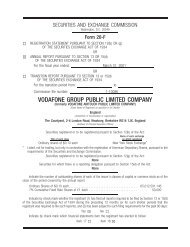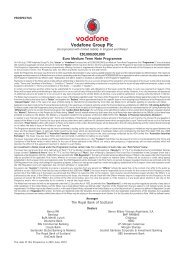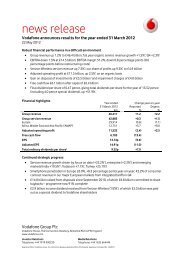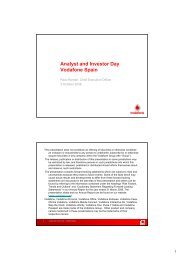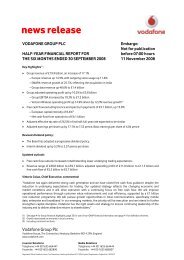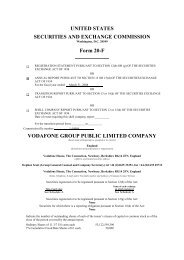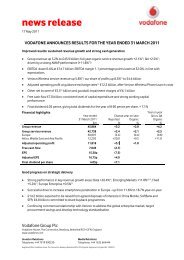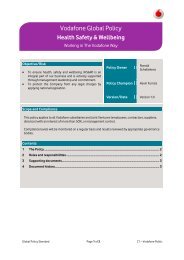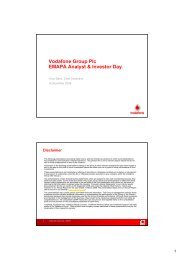You also want an ePaper? Increase the reach of your titles
YUMPU automatically turns print PDFs into web optimized ePapers that Google loves.
<strong>Vodafone</strong> – Financials<br />
Notes to <strong>the</strong> Consolidated Financial Statements continued<br />
2. Significant accounting policies continued<br />
Borrowing costs<br />
All borrowing costs are recognised in <strong>the</strong> income statement in <strong>the</strong> period in which<br />
<strong>the</strong>y are incurred.<br />
Post employment benefits<br />
For defined benefit retirement plans, <strong>the</strong> difference between <strong>the</strong> fair value of <strong>the</strong><br />
plan assets and <strong>the</strong> present value of <strong>the</strong> plan liabilities is recognised as an asset or<br />
liability on <strong>the</strong> balance sheet. Scheme liabilities are assessed using <strong>the</strong> projected<br />
unit funding method and applying <strong>the</strong> principal actuarial assumptions as at <strong>the</strong><br />
balance sheet date. Assets are valued at market value.<br />
During <strong>the</strong> year ended 31 March 2006, <strong>the</strong> Group early adopted <strong>the</strong> amendment<br />
to IAS 19, “Employee Benefits”, and applied it from 1 April 2004. Accordingly,<br />
actuarial gains and losses are taken to <strong>the</strong> statement of recognised income and<br />
expense as incurred. For this purpose, actuarial gains and losses comprise both<br />
<strong>the</strong> effects of changes in actuarial assumptions and experience adjustments<br />
arising because of differences between <strong>the</strong> previous actuarial assumptions and<br />
what has actually occurred.<br />
O<strong>the</strong>r movements in <strong>the</strong> net surplus or deficit are recognised in <strong>the</strong> income<br />
statement, including <strong>the</strong> current service cost, any past service cost and <strong>the</strong> effect<br />
of any curtailment or settlements. The interest cost less <strong>the</strong> expected return<br />
on assets is also charged to <strong>the</strong> income statement. The amount charged to <strong>the</strong><br />
income statement in respect of <strong>the</strong>se plans is included within operating costs or<br />
in <strong>the</strong> Group’s share of <strong>the</strong> results of equity accounted operations as appropriate.<br />
The Group’s contributions to defined contribution pension plans are charged<br />
to <strong>the</strong> income statement as <strong>the</strong>y fall due.<br />
Cumulative actuarial gains and losses as at 1 April 2004, <strong>the</strong> date of transition<br />
to IFRS, have been recognised in <strong>the</strong> balance sheet.<br />
Taxation<br />
Income tax expense represents <strong>the</strong> sum of <strong>the</strong> current tax payable and deferred tax.<br />
Current tax payable or recoverable is based on taxable profit for <strong>the</strong> year. Taxable<br />
profit differs from profit as <strong>report</strong>ed in <strong>the</strong> income statement because some items<br />
of income or expense are taxable or deductible in different years or may never<br />
be taxable or deductible. The Group’s liability for current tax is calculated using<br />
UK and foreign tax rates and laws that have been enacted or substantively<br />
enacted by <strong>the</strong> balance sheet date.<br />
Deferred tax is <strong>the</strong> tax expected to be payable or recoverable in <strong>the</strong> future arising<br />
from temporary differences between <strong>the</strong> carrying amounts of assets and liabilities<br />
in <strong>the</strong> financial statements and <strong>the</strong> corresponding tax bases used in <strong>the</strong><br />
computation of taxable profit. It is accounted for using <strong>the</strong> balance sheet liability<br />
method. Deferred tax liabilities are generally recognised for all taxable temporary<br />
differences and deferred tax assets are recognised to <strong>the</strong> extent that it is probable<br />
that taxable profits will be available against which deductible temporary<br />
differences can be utilised. Such assets and liabilities are not recognised if <strong>the</strong><br />
temporary difference arises from <strong>the</strong> initial recognition (o<strong>the</strong>r than in a business<br />
combination) of assets and liabilities in a transaction that affects nei<strong>the</strong>r <strong>the</strong><br />
taxable profit nor <strong>the</strong> accounting profit. Deferred tax liabilities are not recognised<br />
to <strong>the</strong> extent <strong>the</strong>y arise from <strong>the</strong> initial recognition of goodwill.<br />
Deferred tax liabilities are recognised for taxable temporary differences arising on<br />
investments in subsidiaries and associates, and interests in joint ventures, except<br />
where <strong>the</strong> Group is able to control <strong>the</strong> reversal of <strong>the</strong> temporary difference and it is<br />
probable that <strong>the</strong> temporary difference will not reverse in <strong>the</strong> foreseeable future.<br />
The carrying amount of deferred tax assets is reviewed at each balance sheet date<br />
and adjusted to reflect changes in probability that sufficient taxable profits will be<br />
available to allow all or part of <strong>the</strong> asset to be recovered.<br />
Deferred tax is calculated at <strong>the</strong> tax rates that are expected to apply in <strong>the</strong> period<br />
when <strong>the</strong> liability is settled or <strong>the</strong> asset realised, based on tax rates that have been<br />
enacted or substantively enacted by <strong>the</strong> balance sheet date.<br />
94 <strong>Vodafone</strong> Group Plc Annual Report 2008<br />
Tax assets and liabilities are offset when <strong>the</strong>re is a legally enforceable right to set<br />
off current tax assets against current tax liabilities and when <strong>the</strong>y ei<strong>the</strong>r relate to<br />
income taxes levied by <strong>the</strong> same taxation authority on ei<strong>the</strong>r <strong>the</strong> same taxable<br />
entity or on different taxable entities which intend to settle <strong>the</strong> current tax assets<br />
and liabilities on a net basis.<br />
Tax is charged or credited to <strong>the</strong> income statement, except when it relates to<br />
items charged or credited directly to equity, in which case <strong>the</strong> tax is also recognised<br />
directly in equity.<br />
Financial instruments<br />
Financial assets and financial liabilities, in respect of financial instruments, are<br />
recognised on <strong>the</strong> Group’s balance sheet when <strong>the</strong> Group becomes a party to <strong>the</strong><br />
contractual provisions of <strong>the</strong> instrument.<br />
The Group has applied <strong>the</strong> requirements of IFRS to financial instruments for all<br />
periods presented and has not taken advantage of any exemptions available to<br />
first time adopters of IFRS in this respect. During <strong>the</strong> year ended 31 March 2006,<br />
<strong>the</strong> Group early adopted IFRS 7, “Financial Instruments: Disclosures”,<br />
amendments to IAS 39, “Financial Instruments: Recognition and Measurement”<br />
and IFRS 4, “Insurance Contracts”, regarding “Financial Guarantee Contracts”<br />
and amendments to IAS 39 regarding “The Fair Value Option” and “Cash Flow<br />
Hedge Accounting of Forecast Intragroup Transactions” and applied <strong>the</strong>m from<br />
1 April 2004.<br />
Trade receivables<br />
Trade receivables do not carry any interest and are stated at <strong>the</strong>ir nominal value<br />
as reduced by appropriate allowances for estimated irrecoverable amounts.<br />
Estimated irrecoverable amounts are based on <strong>the</strong> ageing of <strong>the</strong> receivable<br />
balances and historical experience. Individual trade receivables are written off<br />
when management deems <strong>the</strong>m not to be collectible.<br />
O<strong>the</strong>r investments<br />
O<strong>the</strong>r investments are recognised and derecognised on a trade date where<br />
a purchase or sale of an investment is under a contract whose terms require<br />
delivery of <strong>the</strong> investment within <strong>the</strong> timeframe established by <strong>the</strong> market<br />
concerned, and are initially measured at cost, including transaction costs.<br />
O<strong>the</strong>r investments classified held for trading and available-for-sale are stated<br />
at fair value. Where securities are held for trading purposes, gains and losses<br />
arising from changes in fair value are included in net profit or loss for <strong>the</strong> period.<br />
For available-for-sale investments, gains and losses arising from changes in fair<br />
value are recognised directly in equity, until <strong>the</strong> security is disposed of or is<br />
determined to be impaired, at which time <strong>the</strong> cumulative gain or loss previously<br />
recognised in equity, determined using <strong>the</strong> weighted average costs method,<br />
is included in <strong>the</strong> net profit or loss for <strong>the</strong> period.<br />
O<strong>the</strong>r investments classified as loans and receivables are stated at amortised<br />
cost using <strong>the</strong> effective interest method, less any impairment.<br />
Cash and cash equivalents<br />
Cash and cash equivalents comprise cash on hand and call deposits, and o<strong>the</strong>r<br />
short term highly liquid investments that are readily convertible to a known<br />
amount of cash and are subject to an insignificant risk of changes in value.<br />
Trade payables<br />
Trade payables are not interest bearing and are stated at <strong>the</strong>ir nominal value.<br />
Financial liabilities and equity instruments<br />
Financial liabilities and equity instruments issued by <strong>the</strong> Group are classified<br />
according to <strong>the</strong> substance of <strong>the</strong> contractual arrangements entered into and <strong>the</strong><br />
definitions of a financial liability and an equity instrument. An equity instrument<br />
is any contract that evidences a residual interest in <strong>the</strong> assets of <strong>the</strong> Group after<br />
deducting all of its liabilities and includes no obligation to deliver cash or o<strong>the</strong>r<br />
financial assets. The accounting policies adopted for specific financial liabilities<br />
and equity instruments are set out below.




